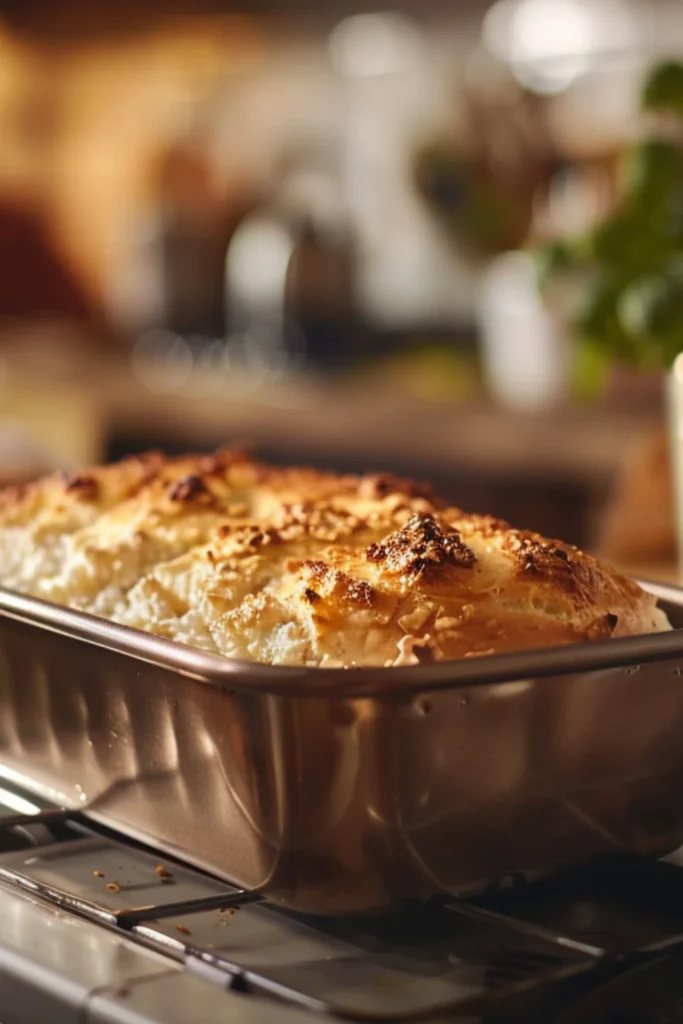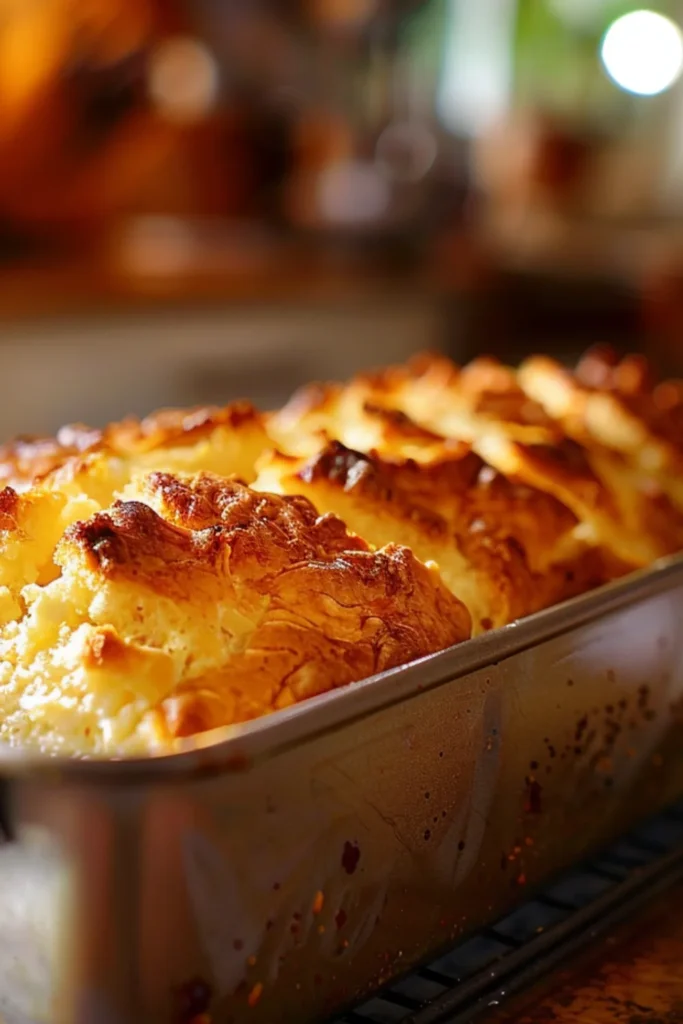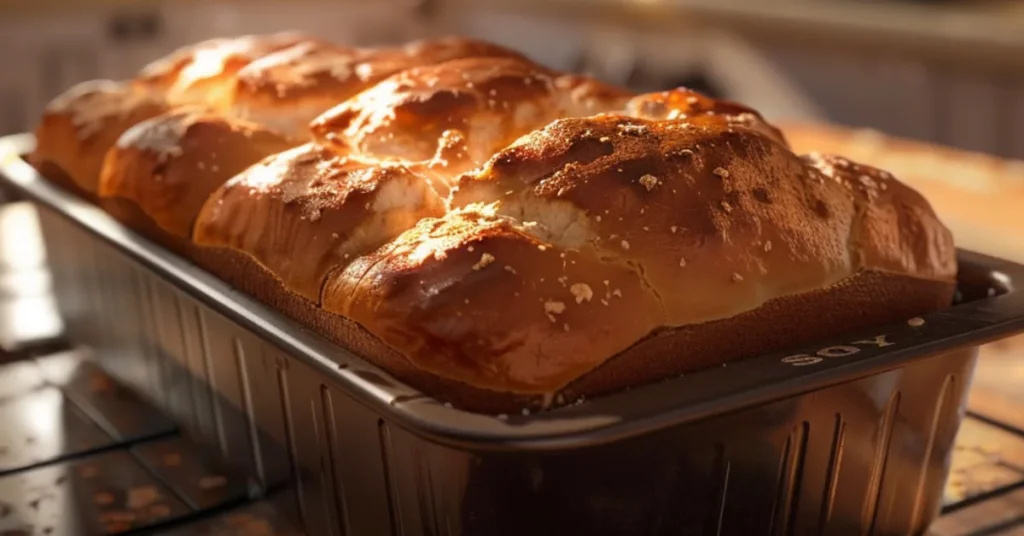Table of Contents
Dive into the world of baking with our detailed guide on the Cottage bread recipe. Discover tips, variations, and the secret to the perfect loaf that brings warmth to every table.
Introduction
Cottage Bread Recipe, a cornerstone of homey, comfort baking, stands out for its rustic charm and delightful flavors. This guide is crafted to escort you through the journey of baking the perfect loaf of cottage bread, from the basic ingredients to advanced baking techniques. With a focus on simple, accessible ingredients and clear, step-by-step instructions, our aim is to instill confidence in bakers of all levels. Let’s embark on this baking adventure together, ensuring your experience with cottage bread is as rewarding as it is delicious.
What Makes Cottage Bread Recipe Unique?
Cottage bread possesses a distinctive texture and flavor profile that sets it apart from other breads. At its core, the combination of flour, water, yeast, and salt undergoes a magical transformation, thanks to the art of baking. Its crust, golden and slightly crisp, encases a soft, airy interior that speaks of home and comfort. This section will explore the unique characteristics of cottage bread, including its ingredients and how they contribute to its beloved status.

More recipes: Easy Baked Ranch Chicken
Essential Ingredients for Cottage Bread Recipe
The simplicity of cottage bread lies in its ingredients, each playing a crucial role in the bread’s final taste and texture. From the type of flour that dictates the crumb to the yeast that breathes life into the dough, understanding these components is key. We’ll delve into the essentials, offering insights into how each ingredient contributes to creating a loaf of cottage bread that’s both satisfying and memorable. Here’s a basic list to get you started:
Flour:
The base of most breads, all-purpose flour is commonly used, but you can also mix it with whole wheat flour for a denser, healthier loaf. For a more traditional touch, bread flour with a higher protein content can give your cottage bread a chewier texture.
Yeast:
Active dry yeast or instant yeast are the most accessible types. Yeast is crucial for causing the bread to rise and develop its fluffy texture.
Water:
Lukewarm water is used to activate the yeast and combine the dry ingredients. The temperature of the water is important; too hot can kill the yeast, and too cold won’t activate it properly.
Salt:
Salt is essential for flavor and also helps control yeast fermentation, affecting the rise of the dough.
Sugar:
A small amount of sugar can help feed the yeast, speed up fermentation, and add a slight sweetness to the bread. Honey or other sweeteners can also be used.
Optional ingredients can include:
- Oil or Butter: Adding fat to the dough can enrich the flavor and soften the texture of the bread.
- Milk: Replacing water with milk can make the bread softer and add richness.
- Eggs: Some recipes include eggs for added richness and color.
Additionally, you might want to incorporate other ingredients for flavor and nutrition, such as seeds (e.g., sunflower, pumpkin, sesame), nuts, dried fruits, or herbs.
Making cottage bread involves mixing these ingredients, kneading the dough, letting it rise, shaping it, and finally, baking. The result is a delicious, crusty loaf that’s perfect for any meal.
Step-by-Step Cottage Bread Recipe
Baking cottage bread is a journey of transformation, one that’s both simple and profound. This comprehensive section breaks down the baking process into manageable steps, from preparing the dough to the final bake. Whether you’re a novice baker or seasoned in the kitchen, these instructions are designed to guide you to success, ensuring a delicious, beautifully risen cottage bread as the outcome.
Ingredients: (Cottage Bread Recipe)
- 3 cups all-purpose flour (you can substitute up to 1 cup with whole wheat flour for a denser loaf)
- 1¼ cups lukewarm water
- 2¼ teaspoons active dry yeast (1 packet)
- 1 tablespoon sugar
- 1½ teaspoons salt
- 2 tablespoons olive oil or melted butter (optional, for a softer crust)
Instructions: (Cottage Bread Recipe)
1. Activate the Yeast:
- In a small bowl, dissolve the sugar in the lukewarm water. Sprinkle the yeast over the top. Let it sit for about 5-10 minutes until it becomes foamy. This indicates that the yeast is active and ready to use.
2. Mix the Dry Ingredients:
- In a large mixing bowl, whisk together the flour and salt.
3. Combine Wet and Dry Ingredients:
- Once the yeast mixture is foamy, add it to the flour mixture along with the olive oil or melted butter (if using). Mix with a wooden spoon or your hands until a shaggy dough forms.
4. Knead the Dough:
- Turn the dough out onto a lightly floured surface. Knead it for about 8-10 minutes until smooth and elastic. If the dough is too sticky, you can add a little more flour, but be cautious not to add too much, or your bread will be too dense.
5. First Rise:
- Place the kneaded dough in a lightly oiled bowl, turning it once to coat. Cover the bowl with a clean kitchen towel or plastic wrap and let it rise in a warm, draft-free place for about 1 hour, or until doubled in size.
6. Shape the Loaf:
- Punch down the dough to release any air bubbles. Turn it out onto a lightly floured surface and shape it into a round loaf. To create the cottage effect, you might divide the dough and shape a smaller ball to place on top of a larger one, securing them together by pinching around the base of the smaller ball.
7. Second Rise:
- Place the shaped loaf on a baking sheet lined with parchment paper. Cover it loosely with a kitchen towel and let it rise again for about 30 minutes, or until it puffs up.
8. Preheat the Oven:
- Preheat your oven to 425°F (220°C) during the second rise.
9. Bake:
- Once the loaf has risen, you can slash the top gently with a sharp knife to help it expand during baking. Place the baking sheet in the oven and bake for about 25-30 minutes, or until the bread is golden brown and sounds hollow when tapped on the bottom.
10. Cool:
- Remove the bread from the oven and let it cool on a wire rack for at least an hour before slicing. This ensures the inside finishes cooking from the residual heat without becoming soggy.

Tips for the Perfect Cottage Bread
Achieving the perfect loaf of cottage bread is within reach with these expert tips. From kneading techniques that develop gluten strength to creating the ideal environment for your dough to rise, we cover all the bases. Learn how to manipulate variables like humidity and temperature to your advantage, transforming good bread into great bread.
Here are some tips to help you master the art of making this rustic, delicious bread:
1. Temperature Matters: (Cottage Bread Recipe)
- Yeast Activation: Ensure your water is lukewarm (about 105°F-115°F or 40°C-46°C) to activate the yeast without killing it. Too hot, and you’ll kill the yeast; too cold, and it won’t activate.
- Dough Rising: The best environment for rising dough is warm and draft-free. If your kitchen is cool, you can place the dough in an oven that’s turned off but with the light on, or on top of a refrigerator where it’s slightly warmer.
2. Hydration Is Key: (Cottage Bread Recipe)
- The water-to-flour ratio can significantly affect your bread’s texture. Cottage bread generally benefits from a slightly sticky dough, as this leads to a lighter, airier loaf. If the dough seems too dry after mixing, don’t be afraid to add a little more water, a tablespoon at a time, until you reach the desired consistency.
3. Kneading Technique: (Cottage Bread Recipe)
- Proper kneading develops the gluten in the flour, which gives the bread structure and texture. Use the heel of your hand to push the dough away from you, then fold it back over itself. Turn the dough a quarter turn and repeat. This process can be therapeutic, but you can also use a stand mixer with a dough hook to save time and energy.
4. First Rise Patience: (Cottage Bread Recipe)
- Allow the dough to rise until it’s doubled in size, which can take anywhere from 1 to 2 hours depending on the temperature of your environment. Rushing this step can result in a denser loaf.
5. Shaping With Care: (Cottage Bread Recipe)
- When shaping your loaf, be gentle to retain as much gas in the dough as possible. This helps achieve a good rise and open crumb structure. For cottage bread, you can create a traditional round loaf or experiment with placing a smaller ball of dough on top of a larger base for a unique, rustic look.
6. Scoring the Dough: (Cottage Bread Recipe)
- Just before baking, score the top of your dough with a sharp knife or a lame. This allows the bread to expand freely in the oven and can also add a decorative touch.
7. Steam for Crust: (Cottage Bread Recipe)
- For a crispier crust, introduce steam into your oven during the first few minutes of baking. You can achieve this by placing a pan of hot water on the bottom rack of your oven or spritzing the oven walls with water. Be careful when opening the oven door.
8. Cooling Completely: (Cottage Bread Recipe)
- Resist the temptation to cut into your bread right out of the oven. Letting it cool on a wire rack for at least an hour allows the interior to set and develop its flavor fully.
9. Experiment and Enjoy: (Cottage Bread Recipe)
- Baking is as much art as science. Each batch of bread can be an opportunity to tweak and improve. Try different flours, hydration levels, and add-ins like seeds or nuts to make your perfect cottage bread.
Variations of Cottage Bread Recipe
Cottage bread is wonderfully versatile, serving as a canvas for culinary creativity. This section explores exciting variations, from herb-infused loaves to incorporating whole grains for added nutrition. For those with dietary restrictions, we also provide guidance on making gluten-free cottage bread, ensuring everyone can enjoy this baking delight.
1. Whole Wheat Cottage Bread:
- Substitute half of the all-purpose flour with whole wheat flour for a nuttier flavor and denser texture. Whole wheat flour adds more fiber and nutrients, making it a healthier option. You might need to adjust the water content slightly, as whole wheat flour absorbs more liquid.
2. Seeded Cottage Bread:
- Incorporate seeds such as sunflower, sesame, pumpkin, or flaxseed into the dough for an extra crunch and nutritional boost. You can mix them into the dough or sprinkle them on top before baking for a decorative touch.
3. Herb Cottage Bread:
- Add dried or fresh herbs like rosemary, thyme, or oregano to the dough for a fragrant, flavorful loaf. These herbs can complement a variety of dishes, from pasta to salads, and enhance the bread’s aroma.
4. Cheese Cottage Bread:
- Fold grated cheese into the dough before the first rise, or sprinkle it on top of the loaf before baking. Sharp cheeses like cheddar, Parmesan, or Gruyère add a savory depth of flavor that pairs wonderfully with the bread’s crusty exterior.
5. Olive Cottage Bread:
- Add chopped olives to the dough to create a Mediterranean-inspired loaf. Black or green olives both work well and can be combined with herbs and a touch of olive oil for a moist, flavorful bread.
6. Multigrain Cottage Bread:
- For a hearty, textured loaf, mix in various grains such as oats, barley, millet, or quinoa. This not only adds complexity to the bread’s flavor but also boosts its nutritional profile with additional fiber and vitamins.
7. Sweet Cottage Bread:
- Modify the recipe to create a sweeter bread by adding more sugar, honey, or even maple syrup. Incorporate dried fruits like raisins, cranberries, or apricots for bursts of sweetness. This variation is excellent for breakfast or as a snack.
8. Gluten-Free Cottage Bread:
- For those avoiding gluten, substitute the wheat flour with a blend of gluten-free flours such as rice flour, tapioca flour, and a binder like xanthan gum. Gluten-free baking can be challenging, and the texture will differ, but it’s possible to make a delicious, gluten-free cottage loaf with experimentation.
9. Sourdough Cottage Bread:
- Use a sourdough starter instead of commercial yeast for leavening. This not only adds a tangy flavor but also improves the bread’s digestibility and nutritional content. Sourdough cottage bread may require a longer fermentation time but can be especially rewarding to make.
Serving and Pairing Suggestions for Cottage Bread Recipe
A loaf of warm, freshly baked cottage bread is a joy in itself, but pairing it with the right accompaniments can elevate the experience. We offer serving and pairing suggestions that complement the bread’s flavors, from savory spreads to hearty dishes that make for a complete meal.
Here are some serving and pairing suggestions to enhance your meals and delight your taste buds:
Breakfast:
- Avocado Toast: Slice the cottage bread thickly, toast it until golden, and top it with mashed avocado, a squeeze of lemon, salt, and pepper. Add a poached egg on top for extra protein.
- French Toast: Soak slices of cottage bread in a mixture of eggs, milk, vanilla, and cinnamon, then fry until golden brown. Serve with maple syrup and fresh berries for a decadent breakfast.
Lunch:
- Soup and Bread: Serve warm slices of cottage bread alongside your favorite soup, such as tomato bisque, lentil soup, or a hearty vegetable stew. The bread is perfect for dipping.
- Sandwiches: The sturdy texture of cottage bread makes it ideal for sandwiches. Try it with classic combinations like ham and cheese, turkey and cranberry, or cucumber and cream cheese.
Dinner:
- Bruschetta: Top toasted slices of cottage bread with a mixture of chopped tomatoes, garlic, basil, olive oil, and balsamic vinegar for a simple yet elegant appetizer.
- With Pasta: Serve a loaf of cottage bread with pasta dishes, such as spaghetti bolognese or fettuccine Alfredo, to soak up the delicious sauces.
Snacks and Sides:
- Cheese and Charcuterie Board: Cottage bread, cut into small pieces or thin slices, makes a wonderful addition to any cheese and charcuterie board, complementing the flavors of various cheeses and meats.
- Olive Oil and Balsamic Dip: Mix olive oil, balsamic vinegar, a little garlic, and herbs for a simple dip for pieces of cottage bread.
Desserts:
- Bread Pudding: Use leftover cottage bread to make bread pudding. Soak the bread in a mixture of milk, eggs, sugar, vanilla, and spices, then bake until custardy. Serve with a dollop of whipped cream or ice cream.
Pairings with Drinks:
- Wine: Cottage bread pairs beautifully with wine. A light, airy loaf goes well with white wines like Chardonnay or Sauvignon Blanc, while a denser, whole wheat version might pair better with red wines like Merlot or Cabernet Sauvignon.
- Cheese: From soft cheeses like Brie or Camembert to hard cheeses like Cheddar or Parmesan, cottage bread can accompany a wide variety of cheeses, enhancing the tasting experience.
- Craft Beers: The nuanced flavors of craft beers, from hoppy IPAs to rich stouts, can complement the simple, earthy qualities of cottage bread.
Storing and Freshness for Cottage Bread Recipe
to keep your loaf fresh for longer, from wrapping techniques to the best storage conditions. Whether you’re saving it for the next day’s breakfast or planning to savor it over a few days, these tips will help maintain its quality and taste.
Short-Term Storage:
- Room Temperature: Keep your bread in a cool, dry place for short-term storage. A bread box or a cupboard away from direct sunlight or heat sources works well. Avoid storing bread in the refrigerator, as it can cause the bread to stale faster due to the cold air affecting the starch molecules.
- Bread Bags: Store the bread in a cotton bread bag or wrapped in a clean, dry kitchen towel. These methods allow the bread to “breathe,” preventing mold growth while keeping the crust crispy.
Long-Term Storage:
- Freezing: For long-term storage, freezing is the best option. Slice the bread before freezing so you can thaw only what you need. Wrap the slices or whole loaf tightly in plastic wrap, then place them in a freezer bag, squeezing out as much air as possible before sealing. Bread can be frozen for up to 3 months. To thaw, leave it at room temperature or toast slices directly from frozen.
Keeping Bread Fresh:
- Reviving Stale Bread: If your bread has started to go stale, you can revive it by lightly sprinkling it with water and warming it in a preheated oven at 350°F (175°C) for about 5-10 minutes. The bread will become warm and soft again, with a rejuvenated crust.
- Microwave Method: For a quick fix, wrap a slice of bread in a damp paper towel and microwave it for 10-15 seconds. This method can help soften slightly stale bread, but be aware that it might make the bread chewy if overdone.
Signs of Spoilage:
- Mold: Check your bread regularly for any signs of mold, especially if stored in a humid environment. Mold can appear as white, green, or black spots. If you see mold, it’s best to discard the entire loaf, as mold spores can spread throughout the bread, even if not visible.
- Off Smell: If the bread smells sour or off, it’s a sign that it has gone bad and should not be consumed.
FAQs About Cottage Bread Recipe
All-purpose flour for cottage bread?
Yes, but it results in a softer loaf compared to using bread flour.
Dough risen enough?
It’s ready when doubled in size and leaves a gentle indentation when poked.
Bread is dense?
Could be due to insufficient kneading, old yeast, or inadequate rising time. Ensure yeast is fresh and follow the recipe’s kneading and rising guidelines.
Making bread without a mixer?
Yes, knead by hand for about 10-15 minutes until the dough is smooth and elastic.
Creating steam in the oven?
Yes, for a crispy crust. Place a pan of water in the oven during preheating and baking.
Adding flavors to bread?
Incorporate herbs, cheeses, olives, dried fruits, or nuts during kneading for an even distribution.




